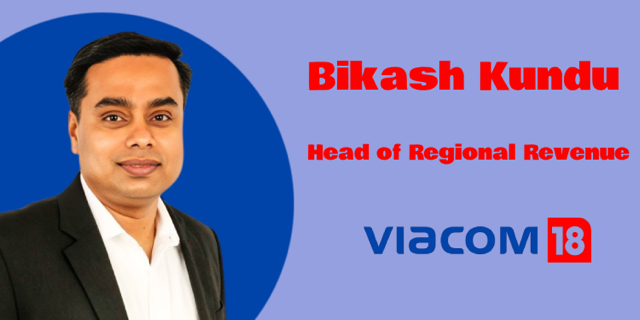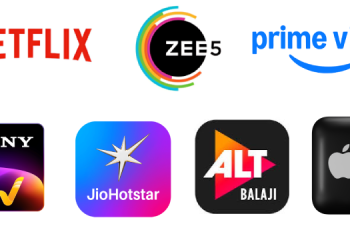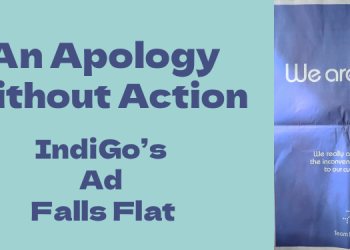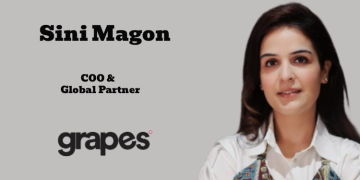Bigg Boss Kannada Season 11 commenced recently on Colors Kannada has once again taken the regional entertainment market by storm. As a leader in Kannada entertainment, the show continues to set new benchmarks in viewership and audience engagement, consistently generating significant buzz on social media.
To explore the driving forces behind this remarkable phenomenon, MediaNews4U caught up with Bikash Kundu, Head of Regional Revenue at Viacom18. In our conversation, Bikash shares valuable insights on the pivotal role Bigg Boss Kannada plays in sustaining revenue growth and forging strong brand partnerships within the regional market. He discusses the innovative strategies that have broadened the show’s appeal, resonating with a diverse audience across Karnataka.
Moreover, we’ll explore how digital and social media are amplifying the show’s reach, fostering deeper engagement, and expanding its influence beyond traditional television. Finally, Bikash highlights why Bigg Boss Kannada has emerged as a prime advertising platform for brands aiming to connect meaningfully with regional audiences.
1. Can you take us through the journey of Bigg Boss Kannada and its association with brands?
We are excited to celebrate the 11th season of Bigg Boss Kannada (BBK), with Kichcha Sudeep who has been an exceptional host from the beginning, has been nothing short of phenomenal. His expertise and charisma make him the perfect fit for this show.
Reflecting on Season 10, it was our most successful yet, achieving remarkable milestones on both television and JioCinema. Out of 113 episodes, 83 episodes achieved a rating of 10+ TVR, with the grand finale delivering over 16 TVR among the Urban Target Group. Overall watch time reached 624 crore minutes, with ratings growing 89% from Season 9 to 10 (from 3.9 to 7.4 TVRs) and reach increasing by 14% to 76.18% on TV.
Brand partnerships were unprecedented, starting with 11 sponsors and growing to 19 by season’s end. This year, BBK11 launched with 21 sponsors and saw pre-launch sponsorship revenue surge by over 20%.
Our partnerships reflect a diverse range of product categories, including local brands like Gemini edible oil and Sadhguru Soap, and national brands such as Philips and Horlicks. The volume and variety of partnerships this season have significantly exceeded our previous benchmarks.
We look forward to continuing this momentum and enhancing the Bigg Boss Kannada experience for our audience and partners
2. Why do you believe Bigg Boss Kannada has emerged as a prime advertising platform for brands targeting the regional audience?
Around 11 years ago, when I began managing regional business, Karnataka was classified as a P3 market among the four southern language markets: Tamil, Telugu, Malayalam, and Kannada. Tamil Nadu was considered P1, Telugu P2, with Kannada at P3 and Malayalam at P4. However, we have seen a significant shift in advertiser interest and a notable increase in audience engagement. Karnataka is now the fastest-growing southern state in terms of engagement. As a result, it has become a vital component of the marketing mix for the southern region.
Season 10 of Bigg Boss Kannada has emerged as the best yet, establishing Bigg Boss as the IPL of General Entertainment Channels (GECs). No other platform or genre rivals Bigg Boss in terms of brand engagement and integration within the house.
For instance, brands like Colgate and Dabur Red Paste have placed their products in the bathroom, while Sarah Sanitary has installed wash basins inside the house, and Surf Excel has branded bathroom doors. Last year, Vaseline creatively branded the powder room.
Food brands are also featured prominently. Products from Freedom Oil, Cadbury, Levista Coffee, and Ching’s Secret are showcased in the kitchen. This year, Haier has supplied the Bigg Boss house with branded refrigerators, microwaves, and LED TVs.
Moreover, the mattresses used in the house are provided by Century Mattress, demonstrating effective branding throughout the season. An interesting integration this year involves Niranthara Lamp Oil, used during prayers to the deity Chamundeshwari. This product is not just branded but actively used by contestants.
Additionally, KRBL, known for Indiagate Basmati Rice, has created segments where contestants prepare pulao and biryani while wearing branded chef’s caps and aprons. Bigg Boss offers numerous opportunities for passive, active, and hyperactive brand integrations.
Significant product launches have also taken place within the Bigg Boss house. For example, Hershey’s launched Kisses in India through a segment featuring Kichcha Sudeep and the contestants. A Tata car was unveiled during the grand finale, with the vehicle awarded as a prize to a winner.
Ultimately, no other platform provides the depth of brand integration that Bigg Boss does. It offers exceptional opportunities for brands to engage with audiences, making Bigg Boss Kannada a valuable space for marketing integration.

3. Can you share specific examples of brand partnerships that have been particularly successful due to the show’s popularity?
Over the years, numerous national and local brands have immensely benefited from their association with Bigg Boss Kannada (BBK), including a notable Karnataka-based company, SLN Coffee. For many years, SLN Coffee has been one of India’s top coffee exporters, supplying renowned brands like HUL and Nestlé. In fact, if you visit a McDonald’s outlet, the coffee beans served there are sourced from SLN Coffee.
Five years ago, SLN Coffee transitioned from B2B to B2C with the launch of their brand, Levista Coffee. Since its inception, Levista has partnered with BBK, and their owner’s direct involvement in negotiations has been instrumental. These local brand owners have a keen understanding of what works for them, ensuring every investment is accountable.
Levista has leveraged BBK not only for consumer engagement but also to expand its network of dealers and distributors. Their sales head has indicated that the association with Bigg Boss has opened many doors for them, facilitating partnerships and reseller opportunities across Karnataka.
Our collaborations have included innovative branding initiatives within the BBK house. For instance, we provided customised coffee mugs for contestants, enhancing brand visibility during emotional talkie tasks where participants shared personal stories over coffee. This integration captured significant attention on television and social media, generating extensive conversations that benefitted Levista.
BBK is the leading show in Karnataka, with over 81% of the population exposed to its content. This extensive reach, combined with active engagement across platforms like JioCinema, has allowed brands like Levista to thrive. For example, in comparing search metrics, we noted a substantial increase in online searches for Levista relative to competitors like Brew and Nescafé following our integrations.
Moreover, we have facilitated unique consumer experiences, such as Nippon Paints’ consumer contest, where winners were invited to the BBK house. Kichcha Sudeep personally engaged with these winners on stage, creating memorable moments tied to their brand.
Local brands, such as Swastik Ghee and Indus TMT, also engage with the show in meaningful ways. For instance, the owner of Indus presents the first runner-up prize, while the cash prize for the winner is awarded by Confident Group’s MD.
This year, we are proud to have 21 sponsors, including both local brands like Hangyo Ice Cream and national partners like Cure Foods and Sharief Bhai Biryani. The diversity of our sponsors reflects the broad appeal and success of Bigg Boss Kannada as a platform for brand engagement.
We are committed to fostering these partnerships and look forward to continued success in enhancing the Bigg Boss Kannada experience for our sponsors and viewers alike.
4. What innovative strategies have you implemented to enhance the show’s appeal among diverse audience?
This season of Bigg Boss Kannada has numerous exciting elements. Our team has carefully selected 16 contestants, creating an eclectic mix that not only reflects diverse backgrounds but also maximises their social media presence and popularity.
A key factor in the success of BBK has been our content team’s expertise in contestant selection. For instance, during Season 10, we featured Pradeep Eshwar, a sitting MLA. His participation generated considerable media buzz and social media engagement, leading to increased viewership. Similarly, last season, a contestant wearing a real tiger claw sparked significant controversy, which further amplified discussions across various media channels.
Controversies like these play a pivotal role in driving ratings and viewer engagement. This year, we introduced a fascinating contestant, Gold Suresh, who is noted for his extravagant display of gold jewelry. Such unique personalities contribute significantly to the show’s appeal.
Moreover, we implemented an innovative strategy for revealing contestants this year. During the finale of a couple’s game show, Raja Rani, we revealed four contestants and engaged viewers by allowing them to vote on whether these contestants should enter ‘heaven’ or ‘hell’ within the BBK format. This interactive approach not only generated excitement but also fostered a sense of viewer investment in the show.
On the launch day, we utilised a unique marketing initiative by placing a front-page advertisement in top Kannada publications. Viewers were encouraged to give a missed call, resulting in a call back from Bigg Boss himself, reminding them to tune in for the premiere. This created a direct connection with the audience and reinforced their anticipation for the show.
In summary, the combination of intriguing contestants, innovative engagement strategies, and effective marketing efforts has positioned Bigg Boss Kannada for continued success. Our content and creative teams consistently deliver compelling narratives that resonate with our audience, driving viewership and brand partnerships.

5. What future trends do you foresee in regional reality television? And how will Bigg Boss Kannada adapt to them?
Colors Kannada consistently deliver reality shows, airing every Saturday and Sunday for 52 weeks. Apart from the Bigg Boss season, which occupies a significant part of our schedule, we host two nonfiction reality shows over the remaining eight months.
The South Indian market has a robust appetite for reality television, driven by high television consumption rates. Notably, viewers in the South engage with television for more hours compared to other regions. The appeal of Bigg Boss lies not just in its format but also in the immense popularity of South celebrities, who enjoy a demigod status among audiences. With Kichcha Sudeep as the host and a cast of celebrity contestants, the celebrity quotient remains at nearly 100%.
We take pride in the fact that Bigg Boss Kannada has continually reinvented itself each year. Last season, Season 10, set a benchmark in terms of viewership both on television and JioCinema. Preliminary data suggests that Season 11 is poised to surpass last year’s ratings, which had a launch episode rating of over 10.
Our success is driven by a compelling combination of celebrity engagement, innovative content, and active viewer participation. On our digital platform, JioCinema, we provide more than just the 90 minutes of weekly televised content; we capture 24/7 footage from the house. This additional content, often referred to as “shoulder content,” offers viewers insights and moments they may not see on television.
We also maintain a 24/7 live feed from the Bigg Boss house, generated by multiple cameras, ensuring that audiences can engage with the contestants in real-time. Furthermore, our interactive features, such as viewer polls, significantly enhance audience engagement. For instance, our polls asking viewers to predict weekly eliminations attract millions of participants, reinforcing their connection to the show.
In conclusion, our dual approach—balancing traditional television with innovative digital content—ensures that Bigg Boss Kannada not only captivates audiences but also achieves impressive ratings. We are excited about the continued growth and engagement of our shows in the reality television landscape.
6. Bigg Boss Kannada is being aired on both TV and OTT platforms. How do you leverage the technology to further engage brands?
Before the launch of Bigg Boss Kannada Season 11, we successfully secured 21 sponsors, with a notable 17 of these brands opting for a dual presence across both television and JioCinema. This integrated pitch for both platforms has proven effective in attracting advertisers.
The engagement strategies vary among brands based on their budget constraints and marketing objectives. For instance, India Gate Basmati Rice, represented by KRBL, has chosen to invest exclusively in television advertising. In contrast, a local favourite in Karnataka, Sharief Bhai Biryani, operated by Cure Foods, has opted for a digital sponsorship on JioCinema while also executing spot buys on television.
Sharief Bhai Biryani’s strategy is particularly innovative. When they advertise on Colors Kannada, they utilise a standard spot buy. However, for their JioCinema advertisements, they incorporate a QR code within the ad. This allows viewers to scan the code, which seamlessly directs them to the Sharief Bhai Biryani page on the Zomato app, enabling immediate ordering of their biryani.
Another example of our effective brand partnerships is with Hangyo, which is running a contest tied to their brand presence on Bigg Boss Kannada. They have collaborated with Swiggy for delivery services, securing favourable terms due to their visibility on our platform.
Additionally, we leverage technology in various contexts. A23Rummy, an online gaming platform that is legal in Karnataka but restricted in five other Indian states, exemplifies this approach. When A23Rummy advertises on television, it reaches a broad audience, including viewers in states where online gaming is permissible. However, when broadcasting on JioCinema, the ads are strategically restricted to only appear in states that allow such gaming activities, ensuring compliance with regional regulations.
These examples illustrate our commitment to utilising technology and innovative advertising solutions to effectively engage brands and audiences. By differentiating between television and JioCinema, we create tailored strategies that enhance brand visibility while adhering to regulatory frameworks.

7. So, can you give us a picture of overall revenue scenario of Bigg Boss Kannada in terms of television versus digital?
Our market offerings are designed as a combined package, integrating both television and digital components. While we showcase deliverables separately, it’s important to note that our approach treats these channels as part of a unified strategy. Consequently, it is challenging for us to bifurcate revenue between TV and digital platforms.
In the past five years, we have observed a significant shift in how clients and brands approach their media strategies. Previously, many clients would engage separate agencies for digital and traditional media. However, there has been a marked convergence in this space. A substantial number of clients now work with a single agency that manages both TV and digital advertising. This evolution is largely due to traditional media agencies developing their digital capabilities, enabling them to offer comprehensive solutions that do not distinguish between the two mediums.
When evaluating revenue related to Bigg Boss, we consider the property as a whole rather than dissecting it by platform. Our focus remains on the overall performance and impact of Bigg Boss Kannada, allowing us to understand its success in a more integrated manner.

















